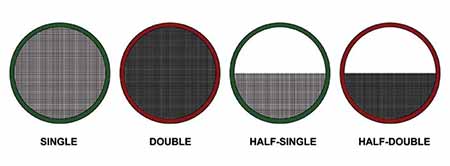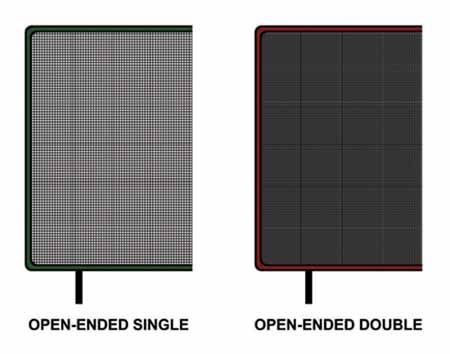Changing Light Intensity

Jay Holben During one of my recent lectures, there was a great deal of confusion about how to adjust light intensity and when does light quality and/or color change when altering the intensity. Although this may seem very basic to some, I realized that many people aren’t clear on this subject. So, let’s shed some proverbial light on it, shall we?
There are three primary tools for changing the intensity of a light source without changing the color or quality of the light: scrims, nets and Neutral Density (ND) gel.
TO SCRIM OR NOT TO SCRIM
The first tool is the most ubiquitous—the metal scrim. As a young electrician I was taught that when I went to get a light, I also got a stand, barn doors and a bag (or box) of scrims. No light was complete without those accompanying items.
Scrims are a woven wire mesh in various densities that can be dropped into the accessory frame of most film lights to change the intensity of the light. This starts with tungsten fixtures and extends to HMIs. You don’t commonly find scrims with fluorescent or LED fixtures. They’re made of metal so that they can withstand the heat intensity of sitting near the lens of a tungsten or HMI fixture.
Scrims come in two standard densities: single and double. The single scrim, which generally has a green metal rim, reduces the light output by 25 percent (1/2 stop). The double generally has a red metal rim and reduces the light output by 50 percent (1 stop). Both of these tools reduce light without altering the color or quality of the light.
Scrims also come in half-scrim variety, where half of the circle is scrim and half is open air. These are used to affect only half of the light source at a time and are handy if a subject has to walk close to a light. If you place a half scrim with the scrim side down in a light fixture, then the subject—at a distance—can be lit with full-strength light; but as they walk towards the fixture, they start to walk into the area of the light altered by the scrim. Therefore, the intensity change as they get closer to the light is negated by the half scrim. Although they are rare, there are also quarter scrims and some graduated scrims.
In Los Angeles, a typical scrim bag (or box) has two doubles, one single, one half-double, one half-single and one open frame (intended to put a gel inside). In New York, a typical scrim bag/box has only one of each. I’m not sure why Hollywood adopted the second double scrim, but I sincerely appreciate the versatility of having it in every bag!
The professional video industry's #1 source for news, trends and product and tech information. Sign up below.
Baseball aficionados will appreciate the slang terms for “dropping” of scrims. A single is a single scrim only. A double is a double scrim only. A triple is a single and a double and a home-run is two doubles in one fixture.
Some people refer to scrims as “diffusion,” but I find this term to be confusing as the scrim’s purpose is not to diffuse the light (although, in actuality, it is to some degree as light reflects off the metal surface of the weave and scatters).
BUT SOFT, WHAT GENTLE NET ARISES

From left: Single, double, half-single and half-double scrims Nets act the same way as scrims; they are a mesh material that reduces light intensity without altering color or quality. Nets, short for “bobbinet,” the woven fabric that they’re most often made from, are fabric and are used away from the fixture, not inside it. They typically come in 18 x 24 inches, 2 x 3 feet and 4 x 4 feet (although there are other sizes available).
Nets follow the same color coding as scrims with green being half of a stop (25-percent reduction in light) and red being one full stop (50-percent reduction in lighting). There are also purple/blue nets, which are a reduction of a 1/4 stop (12.5 percent of light intensity) and are generally a lighter, closer-to-white net, as opposed to the typical black.
Black nets absorb about 90 percent of the light that strikes the woven fabric. A blue net absorbs about 50 percent of the light and can, slightly, change the color of the light output. A white net absorbs about 30 percent of the light and also acts as a slight diffuser by spreading some of the light that reflects off the white threads.
Nets can come in very large sizes, typically called “butterflies”: 6 x 6 feet, 8 x 8 feet, 12 x 12 feet and 20 x 20 feet. These can be used outdoors to reduce the intensity of natural sunlight.
Some of the smaller nets are “open-ended” meaning that they have a standard metal frame on three of the four sides, and only a thin piece of wire connecting the fourth side. This way, you can use the net over only a portion of a light’s beam without putting a hard shadow into your scene from the frame of the net. This works the same way that a half metal scrim works, but you have much more control and flexibility about what portion of the light of which you’re reducing intensity.
OH, FOR A MUSE OF ND
The final tool for altering intensity is neutral density gel. This is, typically, only used when the other two tools are unavailable or for fixtures that don’t have scrims or dimming capability, such as many fluorescent fixtures.
ND gel reduces light output while still allowing full color spectrum to pass through the gel. It is available in densities of 0.3, 0.6, 0.9, 1.2, 1.5 and 1.8—each density represents a stop of light loss, so 1, 2, 3, 4, 5 and 6 stops, respectively.
There are two additional methods of changing intensity without changing color and only slightly affecting quality: shutters and spot/flood.
Shutters are a mechanical device, like window blinds, that you slip into the barn doors of a fixture. You can adjust them to various degrees of open or close. They can introduce shadows, depending on the harness of the light source you’re using them on. They’re typically used for larger Fresnel fixtures such as 5Ks and 10Ks.
Spotting or flooding a fixture changes the relationship of the reflector/bulb to the fixture’s lens to create a more focused, intense beam of light or a more spread-and-diffuse beam. There is a slight change in the quality of light, but it’s subtle, depending on the fixture.
LORD, WHAT CHANGES THESE METHODS BRING

Open-ended single (left) and open-ended double nets Some of the lecture attendees were confused about dimming. Dimming a fixture adjusts the intensity of a light source, but it can also change the color of the light, especially with tungsten lights. As you dim a tungsten, the color temperature drops and gets substantially redder, which can be undesirable for your scene.
Most fluorescent and HMI fixtures cannot be dimmed. Specialty fixtures have built-in dimmers on their ballasts, but their range is often limited. When they’re present, you can safely dim a fluorescent or HMI without altering the color output significantly. Most LED fixtures have built-in dimmers, and dimming does not affect the color of the light from LEDs.
Barn doors are present on many light fixtures, but they serve to cut stray light off unwanted areas, not reduce intensity. Although a secondary effect of cutting of light is a possible reduction in intensity, that is not the door’s primary purpose and adjusting barn doors almost always introduces shadow whereas scrims and nets do not.
Diffusion placed in front of a light definitely reduces the intensity of the light, but it also affects the quality of the light. Even the lightest diffusion will change the light quality to some degree.
Any gel that you place in front of a light will reduce a certain amount of light (with the sole exception of a heat shield, which should not reduce any intensity, only infrared radiation) by the very nature of filters (gels) acting as subtractive color mixing devices—meaning they stop some wavelengths of light from passing through the gel.
Most gels, however—with the exception of diffusion and ND—will alter the color of the light to some degree. In a pinch, when I haven’t had ND on hand, I’ve used a combination of equal strengths of CTO and CTB to create my own ND. It’s not perfect, but it works when no other solution is present.
Finally, altering the distance of a light to a subject will change the intensity, but it will also significantly affect the quality of the light. Moving a fixture further way creates a harder light on the subject.
There are myriad ways to change the intensity of a light source on your subject, but only a handful will only change intensity and not affect color or quality. Knowing when and how to use each technique will help to improve your overall lighting arsenal.
Jay Holben is a contributor to Government Video. He is also the author of the book “A Shot in the Dark: A Creative DIY Guide to Digital Video Lighting on (Almost) No Budget.”
